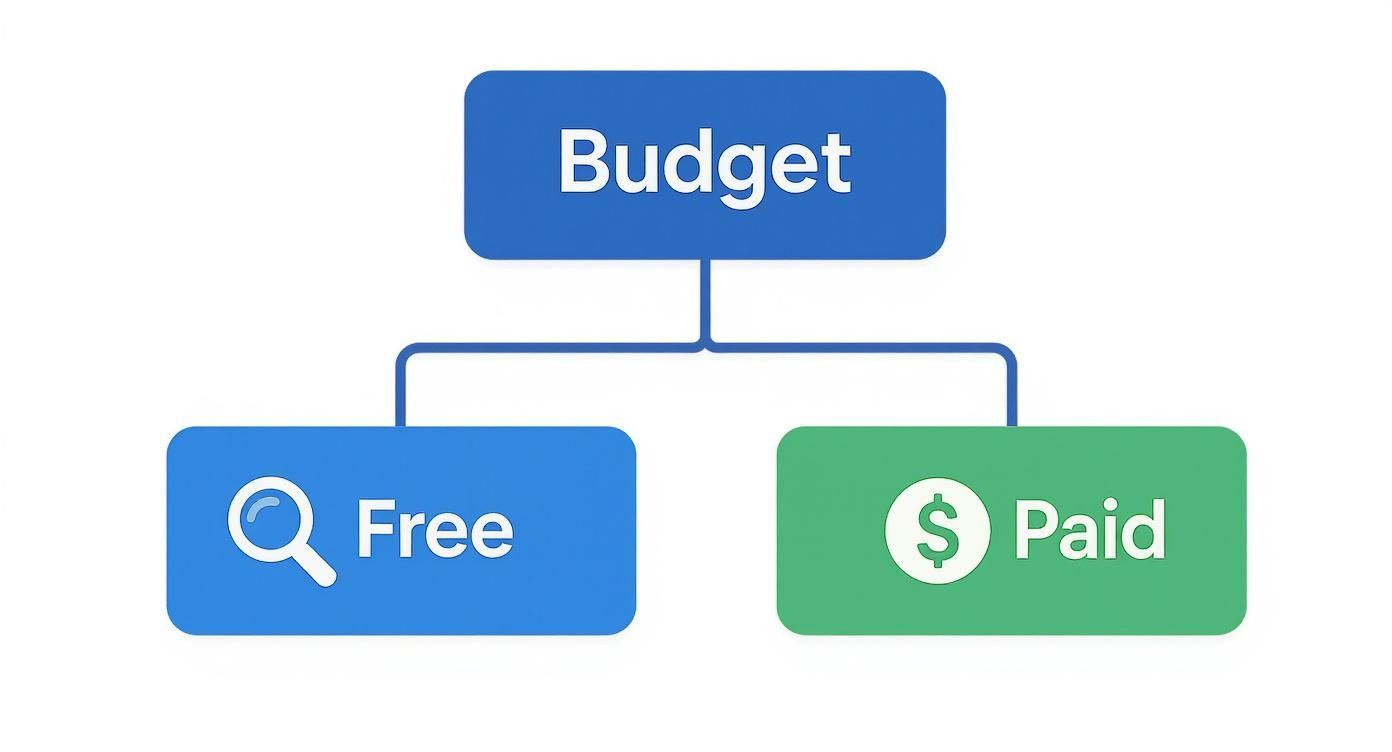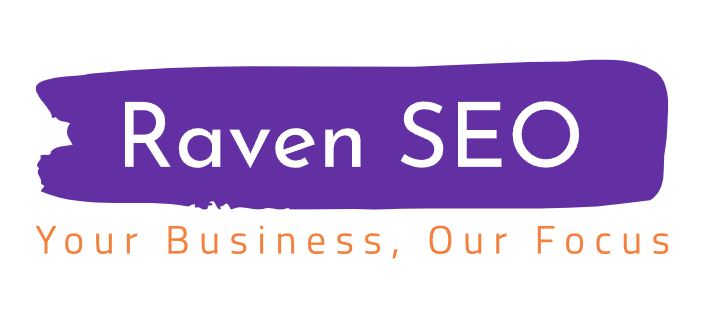Your brand’s reputation on social media isn’t just about PR anymore. It’s the moment-by-moment process of watching, influencing, and shaping how the public sees you across every social network. This guide will teach you how to actively keep an eye on mentions, jump into conversations, and push out content that builds the exact image you want.
This has become absolutely critical. We’ve all seen how a single viral post can either build up or tear down customer trust in an instant, directly impacting whether or not they decide to buy from you.
Why Social Media Reputation Matters Now
Let’s be honest—your brand’s social media profile is the new front door. It’s where people get their first impression, long before they even think about clicking over to your website or walking into your store. What used to be a side channel for marketing is now the main stage for building trust and credibility.
The conversation about your brand is happening 24/7, with or without you. A single unhappy customer tweet that goes unanswered can spiral into a major headache. On the flip side, a glowing review shared on Facebook can become your most powerful ad. This real-time, public forum means managing your reputation is no longer a passive task. It’s a core business function.
From Marketing Task to Business Essential
The sheer scale of social media has completely changed the game. With 65.7% of the global population now scrolling, liking, and sharing, every single interaction can mold your reputation in real time. Proactive management isn’t just a good idea; it’s essential for survival. You can dig into more social media usage stats from Sprinklr to see just how massive this audience is.
If you’re not part of the conversation, you’re letting everyone else write your story for you. A solid reputation management strategy really comes down to a simple, continuous loop.
To truly nail this, you need a solid framework in place. Think of it as having three core pillars holding up your entire social reputation strategy.
The Pillars of Social Reputation Management
This table breaks down the core components of a successful reputation management strategy, providing a quick, educational summary.
| Pillar | Objective | Key Activities |
|---|---|---|
| Listen | Monitor Conversations | Actively track brand mentions, keywords, and industry chatter to understand public perception. |
| Engage | Respond & Participate | Thoughtfully reply to both positive and negative feedback, showing you value your audience. |
| Improve | Act on Feedback | Use insights from social conversations to make meaningful improvements to products and services. |
This continuous cycle transforms your social presence from a simple broadcast tool into a powerful feedback loop. It’s a fundamental part of building a strong online presence, and you can learn more about laying the groundwork by exploring these social media marketing basics.
Building Trust in a Transparent World
In a world where everyone is looking for authenticity, customers are drawn to brands that are open and responsive. The way you handle a public slip-up or a critical comment says far more about your company’s values than any polished ad campaign ever could.
A prompt, empathetic response can single-handedly turn a frustrated customer into one of your biggest fans.
By actively participating in the conversation, you build a reservoir of goodwill. This positive sentiment acts as a buffer, making your brand more resilient when the inevitable negative comment appears.
Ultimately, a strong reputation on social media has a direct impact on your bottom line. It influences buying decisions, helps you attract top talent, and builds a loyal community that feels connected to your brand. It’s not just about crisis management; it’s about building a brand people are genuinely proud to support.
Building Your Social Listening Toolkit
Effective reputation management starts with knowing what people are saying about you. You simply can’t manage conversations you don’t see, which makes a solid social listening system your first line of defense—and opportunity. This isn’t about dropping a ton of money on fancy software; it’s about building a process to keep your finger on your brand’s pulse in real time.
The goal here is to create a dashboard, or even just a simple, organized system, that keeps tabs on brand mentions, what your competition is up to, and key industry chatter. This gives you a clear view of public sentiment, helping you spot potential issues before they spiral into full-blown crises.
Choosing Your Monitoring Tools
Your toolkit can range from free, no-nonsense options to paid platforms loaded with advanced analytics. The right mix really just depends on your budget and what you’re trying to accomplish.
- Free Tools: Services like Google Alerts are a fantastic starting point. You can set up alerts for your brand name, key people, product names, and even your top competitors. You’ll get an email whenever new mentions pop up online. It’s simple, but it works.
- Paid Platforms: Tools like Brandwatch or Hootsuite offer much deeper capabilities. They provide detailed sentiment analysis, track conversations across countless platforms all in one place, and deliver sophisticated reports that can inform your entire marketing strategy.
A local cafe, for example, might get by just fine with Google Alerts for its name and the names of nearby competitors. But as it grows, it might invest in a paid tool to analyze how people feel about its new menu items or to track how well a social media campaign is performing. A key piece of the puzzle is establishing effective social listening practices, which these tools make possible.
This screenshot gives you a basic idea of what’s involved, breaking the process down into manageable steps.
As you can see, monitoring leads directly to analysis and then to action. It’s a continuous loop that powers your entire reputation management effort.
Setting Up Your Listening Posts
Once you’ve picked your tools, the next job is to configure them to catch the most important conversations. Don’t just track your brand name; you need to think a bit broader to get the complete picture.
Your social listening setup should be comprehensive enough to catch direct tags, indirect mentions, and broader industry discussions. This ensures you’re not just reacting to feedback but are also staying ahead of trends and competitor movements.
Make sure you set up alerts and streams for these categories:
- Brand Keywords: Your company name, all your product names, and even common misspellings of them. You’d be surprised how often those pop up.
- Competitor Keywords: The names of your direct competitors and their flagship products. Knowing what’s being said about them is just as important as knowing what’s being said about you.
- Industry Keywords: Terms and phrases relevant to your niche. This helps you understand broader customer needs and pain points, often before they’re directed at you.
By systematically monitoring these areas, you transform all that raw social media chatter into intelligence you can actually use. This proactive approach is a cornerstone of any successful strategy, a topic we explore further in our other guides on reputation management.
How to Respond to Positive and Negative Feedback
Every single comment, tag, and DM is an opportunity to either build up or tear down your brand’s reputation. How you handle feedback—both the glowing praise and the pointed criticism—says everything about who you are as a company. A quick, thoughtful response can turn a happy customer into a lifelong advocate or a frustrated one into a surprisingly loyal fan.
Simply ignoring feedback just isn’t an option anymore. One study found that 94% of customers have actively avoided a business because of something negative they saw online. That stat alone should tell you how critical it is to have a clear game plan for engaging with your audience, making sure no comment gets left behind. Your response protocol is a huge piece of managing your reputation on social media.
Responding to Positive Feedback
When a customer leaves a positive comment or review, it’s a gift. Don’t just “like” it and scroll on. This is your chance to amplify that positivity and show you’re paying attention. A personal acknowledgment makes people feel seen and appreciated.
Here’s how to make the most of it:
- Get Personal With Your Reply: Use their name and mention something specific from their comment. Instead of a generic “Thanks!”, try something like, “Jane, we’re so thrilled you loved the new menu item!”
- Keep the Conversation Going: Ask a follow-up question or invite them back. Something simple like, “We can’t wait for you to come back and try our seasonal specials,” works wonders.
- Share the Love: Ask for their permission to feature their review as user-generated content (UGC). This is powerful social proof that can sway potential new customers.
Handling Negative Feedback Gracefully
Negative comments can feel like a punch to the gut, but they’re also a goldmine of unfiltered insight. If you handle them the right way, you can defuse a tense situation and show everyone watching that you’re committed to getting things right. The trick is to respond publicly first, then move the conversation to a private channel.
Acknowledge the problem in public, apologize with genuine sincerity, and then offer to solve it in private. This shows other users that you take their concerns seriously without broadcasting sensitive customer details for the world to see.
Just follow this simple framework:
- Reply Quickly: Acknowledge the comment within a few hours. A fast reply shows you’re on the ball and that you actually care about their experience.
- Apologize and Empathize: Kick things off with a real apology, like, “We’re so sorry to hear you had this experience.” It shows you understand their frustration.
- Take It Offline: Give them a direct way to resolve the issue, like an email address or a request to send a direct message. This gets the specific details out of the public feed.
To even catch all this feedback in the first place, you need the right tools. This decision tree can help you figure out whether a free or paid social listening tool is the right fit for your budget.

This flowchart breaks down the choice between basic free tools for simple monitoring and more advanced paid platforms that offer deeper analytics and sentiment tracking.
Of course, sometimes negative feedback can escalate into something much bigger. When you’re dealing with more serious issues, having a solid understanding of social media crisis management is absolutely essential to protect your brand. It gives you a playbook for those high-stakes moments.
And if you’re just getting your social channels off the ground, remember that having a consistent response strategy is one of the 5 essential steps to kickstart your social media presence.
Proactively Building a Positive Reputation

The best way to handle negative feedback is to build such a strong foundation of positive sentiment that the occasional bad comment barely makes a dent. Instead of just playing defense and reacting to problems, a proactive approach to reputation management on social media is all about creating a deep reservoir of goodwill.
This makes your brand more resilient when something inevitably goes wrong.
It’s about actively encouraging authentic reviews, showcasing real customer wins, and turning your happiest clients into your most vocal advocates. When you build this kind of trust, you control your brand’s narrative from a position of strength, not desperation.
Encourage Authentic Customer Reviews
Online reviews are the new word-of-mouth, and their power is staggering. In fact, a whopping 93% of consumers say online reviews directly influence what they buy. A steady stream of positive, genuine feedback is one of the most powerful assets you can have.
The trick is to make it incredibly easy for satisfied customers to share their thoughts. Don’t be afraid to ask for feedback at the right moment, like right after a successful purchase or a great customer service chat.
Simply sending a follow-up email with a direct link to your preferred review platform can massively increase the volume of feedback you get. The easier you make it, the more likely people are to actually do it.
Spark User-Generated Content Campaigns
User-generated content (UGC) is pure gold because it’s authentic social proof. It’s your actual customers creating marketing content for you, which is infinitely more persuasive than anything your team could dream up. A simple campaign is a fantastic way to get the ball rolling.
Imagine a local coffee shop running a contest asking customers to post photos with their favorite drink using a special hashtag. It’s simple, but effective.
- Offer a Simple Incentive: The prize doesn’t need to be extravagant. A gift card or a feature on your social media page is often more than enough to get people excited.
- Create a Unique Hashtag: A branded hashtag makes it a breeze to track all the entries and creates a living, searchable gallery of your customers loving your product.
- Always Ask for Permission: Before you repost any customer content, make sure you get their permission. It shows respect and helps you build a much stronger, more engaged community.
This type of content shows real people having real, positive experiences with your brand. To dig deeper into how this builds credibility, check out our guide on the power of E-E-A-T for crafting high-quality content.
Launch a Simple Brand Ambassador Program
You don’t need a huge budget to start a powerful brand ambassador program. The first step is to identify your most loyal and engaged followers—the ones who are always liking, commenting, and sharing your posts. These are your superfans.
Reach out to them personally. Offer them a small token of appreciation, like an exclusive discount code or early access to new products, in exchange for regularly sharing their experiences.
This simple act formalizes their advocacy and gives you a dedicated group of supporters who can amplify your positive messages and even jump in to defend your brand when needed.
Navigating Authenticity and AI in Reputation Management
The ground is shifting under our feet when it comes to online reputation. Today’s customers are sharp, skeptical, and have a built-in detector for anything that feels fake. The old playbook of just shouting positive messages from the rooftops is officially dead.
What people want now is genuine connection and transparency. This shift is happening right as artificial intelligence is exploding in the marketing world. While AI can be a massive help behind the scenes, it also brings a new risk: losing that human touch that actually builds trust. The real challenge is finding that sweet spot between using powerful tech and keeping things real.
The FTC Crackdown and Why Trust Matters More Than Ever
Even the regulators are catching on. The Federal Trade Commission (FTC) is now cracking down hard on fake and AI-generated reviews, driven by a jaw-dropping 758% increase in their appearance online. This isn’t just a regulatory headache; it’s a massive warning sign about digital authenticity.
When you consider that 39% of customers say they only trust a brand after they’ve interacted with it on social media, you can see why this is so critical. You can dig into more of the data in this report on online reputation management statistics.
This new reality means your brand absolutely has to be ethical about how it gathers feedback.
- Don’t pay for praise: Offering gift cards or discounts for five-star reviews is a huge red flag for consumers and the FTC. The goal is honest feedback, not bought-and-paid-for praise.
- Make it easy: After a great customer interaction, give them a simple, direct link to leave a review on a platform they already trust. Remove all the friction.
- Show off the real stuff: Highlight genuine customer testimonials and user-generated content (with their permission, of course). This builds social proof that feels earned because it is.
How to Use AI the Right Way
AI should be your secret weapon, not your public voice. Think of it as the brilliant analyst in your back room, not the person shaking hands at the front door. The moment a customer feels like they’re talking to a machine, you’ve lost.
Use AI to listen and analyze at a scale no human team could ever manage. But when it’s time to talk, a human needs to be driving the conversation.
Here’s how you can strike that perfect balance:
- Sentiment Analysis: Let AI tools sift through thousands of brand mentions in real-time. They can instantly flag conversations that are turning negative or need an urgent human response, so you can jump in before things escalate.
- Trend Spotting: AI is incredible at connecting the dots. It can spot recurring themes in customer comments—like a bug in your latest software update or a gap in your customer service—way faster than a person ever could.
- First-Draft Assistance: AI can help your team create initial drafts for responses, saving valuable time. But the key is that a real person must always review, personalize, and hit “send” to ensure the tone is genuine and empathetic.
The goal isn’t to replace your team but to empower them. By learning how to navigate the AI frontier, you can maintain total control over your digital voice while making sure the human element of your brand always shines through.
Got Questions? We’ve Got Answers
When you’re managing a brand’s reputation on social media, things can get tricky. New situations pop up all the time, and knowing the right move isn’t always obvious. Here are some of the most common questions we get, with clear, straightforward answers to help you navigate the chaos.
How Fast Should I Respond to Comments?
You need to be quick. Really quick. We always aim to respond to all comments, especially the negative ones, within a few hours at the absolute most.
There’s a good reason for this. A study found that 42% of consumers expect a brand to get back to them on social media in under 60 minutes. A fast reply not only shows you’re paying attention but also stops a single negative comment from snowballing into a full-blown crisis while everyone waits for you to say something.
Should I Just Delete Negative Comments?
I know it’s tempting, but whatever you do, resist the urge to hit that delete button. Deleting negative feedback almost always backfires. It makes you look defensive, like you’re trying to hide something, and usually just provokes the person to post again, but this time they’ll be even angrier.
The only exception? When a comment is pure spam, contains hate speech, or is a personal attack on someone. For everything else, it’s far better to face the criticism head-on and handle it professionally for all to see.
A negative comment isn’t an attack; it’s an opportunity. When you respond thoughtfully and publicly, you’re not just talking to one unhappy person. You’re showing everyone else who’s watching that you care, you listen, and you’re committed to making things right. It can turn a bad situation into a powerful display of your brand’s integrity.
What’s the Real Difference Between Social Listening and Social Monitoring?
People often use these terms interchangeably, but they play two very different—and equally important—roles in managing your reputation.
- Social Monitoring is all about collecting the data. It’s the day-to-day work of finding and gathering every mention of your brand, your competitors, or key industry terms. Think of it as the reactive part of the job—finding the fires so you can put them out.
- Social Listening, on the other hand, is about analyzing that data to see the big picture. It’s looking for trends in sentiment, understanding the why behind the conversations, and using those insights to make smarter business decisions. It’s proactive and strategic.
Can I Just Automate My Responses to Save Time?
Automation has its place, but using it for direct customer responses is a risky game. Canned, robotic answers make your brand feel cold and impersonal, which is the exact opposite of the trust you’re trying to build. We’ve all seen those generic “We’re sorry for your experience” replies—they do more harm than good.
AI can be a great starting point for drafting a reply that a real person can then review, personalize, and send. But that final message absolutely needs a genuine, human touch. Empathy can’t be automated. Real conversations build real connections, and that’s what reputation management is all about.
At Raven SEO, we don’t just build websites; we build and protect reputations. Our team blends strategic social media management with expert SEO to make sure your business is not only easy to find but also deeply trusted by your customers. Let us help you turn your social presence into your most powerful asset.




